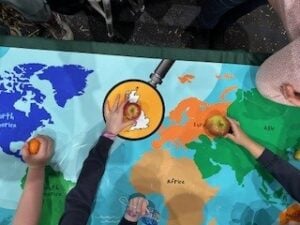Fruit Miles Activity Guide

This activity helps children explore where fruit comes from, how it grows, and how far it travels to reach us. It encourages curiosity about food origins, seasonality, and the environmental impact of our choices in a fun, hands-on way.
At the event we attended, we only had 5 minutes for a group of 15 children, on repeat, but you can adapt it to suit your time frame.
Audience: Teachers, youth group leaders
Theme: Food miles, seasonality, and global fruit origins
Age range: Adaptable for ages 5–13
🌱 Key Messages
- Fruit grows on plants and different fruits grow in different ways (trees, bushes, vines, ground).
- Locally grown, seasonal fruit is often picked when ripe, tastes better, and travels fewer miles.
- Seasonal eating can reduce energy use and support local communities.
- Imported food isn’t bad some long-distance foods may be grown sustainably or transported efficiently.
- Diversity in our diets supports biodiversity and our health.
This activity is designed to spark curiosity, not to judge food choices. It’s about helping children think critically and positively about where their food comes from.
✅ What You’ll Need
- Fresh fruit: Choose a mix of locally grown and imported fruits. Include duplicates from different countries (e.g. UK apples vs. New Zealand apples).
- World map: Use a large printed map (e.g. from Canva) or draw one on wallpaper. Make sure continents are clearly marked.
- Fruit-growing images: Show how different fruits grow (tree, bush, vine, ground).
- Fruit origin list: Have on hand the country of origin and approximate travel distance (food miles).
- Optional: Baskets of seasonal produce to decorate your space.
🧠 Activity Steps
- Split into teams (optional): Up to 8 per team works well. Adapt based on group size and space.
- Give each child a fruit (or a small cup of berries).
- Ask them to place their fruit on the map where they think it’s grown.
- Prompt discussion:
- Where are we now?
- What season is it?
- Could this fruit grow here?
- Have you seen it growing before?
- Reveal the real origins: Share surprising facts (e.g. supermarket apples from New Zealand travel 12,000 miles!).
❓ Curiosity Questions
- What are food miles?
- Why is local food important?
- Have you ever picked your own fruit?
- What’s your favourite fruit?
- Do you eat a rainbow of fruits each week?
- How does this fruit grow? (Use images: tree, bush, vine, ground)
- How long does it take to grow? (e.g. pineapple = 2 years!)
- Why is fruit good for you? (Talk about vitamins, fibre, colour benefits)
- How many apple varieties are grown in the UK? (Answer: 2,500)
- What are dried grapes and dried plums?
🍎 Tips
- Kids love tasting! Offer small samples (wash fruit beforehand).
- Decorate with seasonal produce to make your space inviting.
- Use pictures to help identify fruits.
- Older children can explore deeper topics like biodiversity and organic farming.
🔄 Adaptations
- Make it a team competition with points.
- Use vegetables instead of fruit.
- Explore growing methods and biodiversity.
- Discuss organic farming and sustainability.